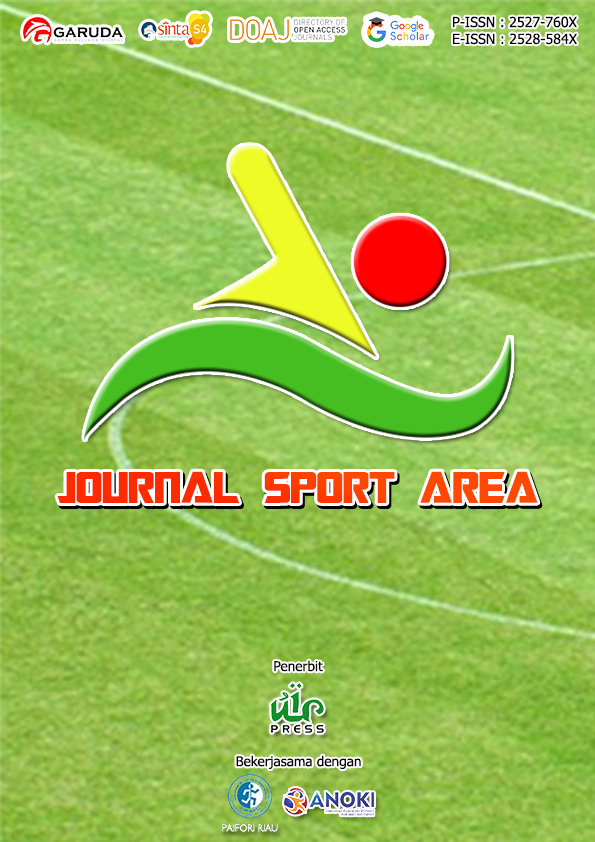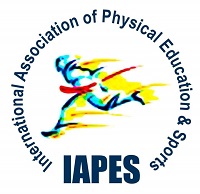The importance of physical activity participation among persons with disabilities
Keywords:
Persons with disabilities, physical activity participation, benefits of exercise, social support, genderAbstract
Participation in physical activity and sports is beneficial for psychosocial health among children and adolescents with a disability. People with disabilities are far less likely to engage in physically active lifestyles than are people without disabilities. This study was conducted to investigate the importance of physical activity participation for persons with disabilities. A total of 100 (men = 59, women = 41) persons with disabilities aged between 10 to 40 years old participated in the study. The instrument used was The Benefits of Exercise towards Persons with Disabilities and Social Support to Exercise for Persons with Disabilities developed by Rauzon designed to investigate the importance of physical activity for disabled persons. The research instrument used for this study was a questionnaire on demographics, the benefits of exercise and social support for exercise. Overall, both men and women agreed with five main statements regarding the benefits of exercise: that they can improve blood pressure and cholesterol levels, help to avoid disease, give more energy, help to relieve tension and to have a more positive outlook on life. There is no significant relationship between family support and physical activity participation. However, for social support, there is a significant relationship between friend support and physical activity participation. The most selected statements for social support for both men and women such as offer to exercise with them, complain about the time they spend for exercise, fun exercise, rewards and help to plan activities around their exercise. Physical activity participation for persons with abilities appears to have many benefits, and this knowledge should be shared not only among the disabled but also the non-disabled as it will help them to become better caregivers who will encourage and support the disabled in physical activities. For a deeper insight, further research with more variables is recommended.
Downloads
References
Abdullah, N. M., Mohamed, M., Tumijan, W., Parnabas, V., Ponnusamy, V., Shapie, M. N. M., & Omar-Fauzee, M. S. (2016). The Differences in Physical Fitness Levels Between Hearing and Visually Impaired Students. In Proceedings of the 2nd International Colloquium on Sports Science, Exercise, Engineering and Technology 2015 (ICoSSEET 2015) (pp. 203–213). https://doi.org/10.1007/978-981-287-691-1_22 DOI: https://doi.org/10.1007/978-981-287-691-1_22
Abdullah, N. M., Tumijan, W., Parnabas, V., Shapie, M. N. M., Hamid, N. A., Mohamed, M., & Ahmad, A. (2016). Predicting the Physical Fitness Level Among Students with Hearing Impairment. Proceedings of the 2nd International Colloquium on Sports Science, Exercise, Engineering and Technology 2015 (ICoSSEET 2015), 2015(ICoSSEET 2015), 67–77. https://doi.org/10.1007/978-981-287-691-1 DOI: https://doi.org/10.1007/978-981-287-691-1_7
Anderson, K. K. (2012). Participation and children with physical disabilities: A program evaluation of a physical activity curriculum for children with physical disabilities in the Fargo Moorhead area. University of Agriculture and Applied Science.
Brundage, V. M. (2011). The influence of parent/caregiver physical activity levels on the physical activity levels of children/adults with disabilities. Indiana University of Pennsylvania.
Calzonetti, K. A. (1988). Participation in physical activity by disabled females in Canada. University of Alberta.
Cane, J., O’Connor, D., & Michie, S. (2012). Validation of the theoretical domains framework for use in behaviour change and implementation research. Implementation Science, 7(1), 1–17. https://doi.org/10.1186/1748-5908-7-37 DOI: https://doi.org/10.1186/1748-5908-7-37
Carlon, S. L., Taylor, N. F., Dodd, K. J., & Shields, N. (2013). Differences in habitual physical activity levels of young people with cerebral palsy and their typically developing peers: A systematic review. Disability and Rehabilitation, 35(8), 647–655. https://doi.org/10.3109/09638288.2012.715721 DOI: https://doi.org/10.3109/09638288.2012.715721
Cremer, N., Hurvitz, E. A., & Peterson, M. D. (2017). Multimorbidity in Middle-Aged Adults with Cerebral Palsy. The American Journal of Medicine, 130(6), 744–744. https://doi.org/10.1016/j.amjmed.2016.11.044 DOI: https://doi.org/10.1016/j.amjmed.2016.11.044
Ginis, K. A. M., Nigg, C. R., & Smith, A. L. (2013). Peer-delivered physical activity interventions: An overlooked opportunity for physical activity promotion. Translational Behavioral Medicine, 3(4), 434–443. https://doi.org/10.1007/s13142-013-0215-2 DOI: https://doi.org/10.1007/s13142-013-0215-2
Lee, B. (2004). Parental values and concerns about participation in physical activity by persons with intellectual disabilities. Michigan State University.
Mckenzie, G., Willis, C., & Shields, N. (2021). Barriers and facilitators of physical activity participation for young people and adults with childhood-onset physical disability: a mixed methods systematic review. Developmental Medicine and Child Neurology, 63(8), 914–924. https://doi.org/10.1111/dmcn.14830 DOI: https://doi.org/10.1111/dmcn.14830
Mulligan, H. F., Hale, L. A., Whitehead, L., & David Baxter, G. (2012). Barriers to physical activity for people with long-term neurological conditions: A review study. Adapted Physical Activity Quarterly, 29(3), 243–265. https://doi.org/10.1123/apaq.29.3.243 DOI: https://doi.org/10.1123/apaq.29.3.243
Oh, A., & So, W. Y. (2022). Assessing the Needs of People with Disabilities for Physical Activities and Sports in South Korea. Healthcare (Switzerland), 10(2), 1–17. https://doi.org/10.3390/healthcare10020265 DOI: https://doi.org/10.3390/healthcare10020265
Pitchford, E. A., Siebert, E., Hamm, J., & Yun, J. (2016). Parental perceptions of physical activity benefits for youth with developmental disabilities. American Journal on Intellectual and Developmental Disabilities, 121(1), 25–32. https://doi.org/10.1352/1944-7558-121.1.25 DOI: https://doi.org/10.1352/1944-7558-121.1.25
Rauzon, T. A. (2002). Barriers to participation in physical activity/exercise for women with physical disabilities (Doctoral dissertation). University of Utah.
Shields, N., & Synnot, A. (2016). Perceived barriers and facilitators to participation in physical activity for children with disability: A qualitative study. BMC Pediatrics, 16(1), 1–10. https://doi.org/10.1186/s12887-016-0544-7 DOI: https://doi.org/10.1186/s12887-016-0544-7
Te Velde, S. J., Lankhorst, K., Zwinkels, M., Verschuren, O., Takken, T., de Groot, J., Backx, F. J. G., de Groot, J. F., Lankhorst, K. M., Nijboer, T. C. W., Takken, T., Smits, D. W., Verschuren, O. W., Visser-Meily, J. M. A., Volman, M. J., & Wittink, H. W. (2018). Associations of sport participation with self-perception, exercise self-efficacy and quality of life among children and adolescents with a physical disability or chronic disease—a cross-sectional study. Sports Medicine - Open, 4(1), 1–11. https://doi.org/10.1186/s40798-018-0152-1 DOI: https://doi.org/10.1186/s40798-018-0152-1
Verschuren, O., Peterson, M. D., Balemans, A. C. J., & Hurvitz, E. A. (2016). Exercise and Physical Activity Recommendations for People with Cerebral Palsy. Developmental Medicine & Child Neurology, 58(8), 798–808. https://doi.org/10.1111/dmcn.13053 DOI: https://doi.org/10.1111/dmcn.13053
Visagie, S., Eide, A. H., Dyrstad, K., Mannan, H., Swartz, L., Schneider, M., Mji, G., Munthali, A., Khogali, M., Rooy, G. van, Hem, K. G., & MacLachlan, M. (2017). Factors related to environmental barriers experienced by persons with and without disabilities in diverse African settings. PLoS ONE, 12(10), 1–14. https://doi.org/10.1371/journal.pone.0186342 DOI: https://doi.org/10.1371/journal.pone.0186342
Waltersson, L., & Rodby-Bousquet, E. (2017). Physical Activity in Adolescents and Young Adults with Cerebral Palsy. BioMed Research International, 2017, 1–6. https://doi.org/10.1155/2017/8080473 DOI: https://doi.org/10.1155/2017/8080473
Whitney, D. G., Hurvitz, E. A., Ryan, J. M., Devlin, M. J., Caird, M. S., French, Z. P., Ellenberg, E. C., & Peterson, M. D. (2018). Noncommunicable disease and multimorbidity in young adults with cerebral palsy. Clinical Epidemiology, 10, 511–519. https://doi.org/10.2147/CLEP.S159405 DOI: https://doi.org/10.2147/CLEP.S159405
Wilhite, B., Martin, D., & Shank, J. (2016). Facilitating Physical Activity among Adults with Disabilities. Therapeutic Recreation Journal, 50(1), 33–54. https://doi.org/10.18666/trj-2016-v50-i1-6790 DOI: https://doi.org/10.18666/TRJ-2016-V50-I1-6790
Williams, T. L., Smith, B., & Papathomas, A. (2014). The barriers, benefits and facilitators of leisure time physical activity among people with spinal cord injury: a meta-synthesis of qualitative findings. Health Psychology Review, 8(4), 404–425. https://doi.org/10.1080/17437199.2014.898406 DOI: https://doi.org/10.1080/17437199.2014.898406
Published
How to Cite
Issue
Section
This is an open-access article distributed under the terms of the Creative Commons Attribution-ShareAlike 4.0 International License which permits unrestricted use, distribution, and reproduction in any medium. Users are allowed to read, download, copy, distribute, search, or link to full-text articles in this journal without asking by giving appropriate credit, provide a link to the license, and indicate if changes were made. All of the remix, transform, or build upon the material must distribute the contributions under the same license as the original.
Accepted 2022-07-14
Published 2022-08-06



.png)




















.png)







.png)





